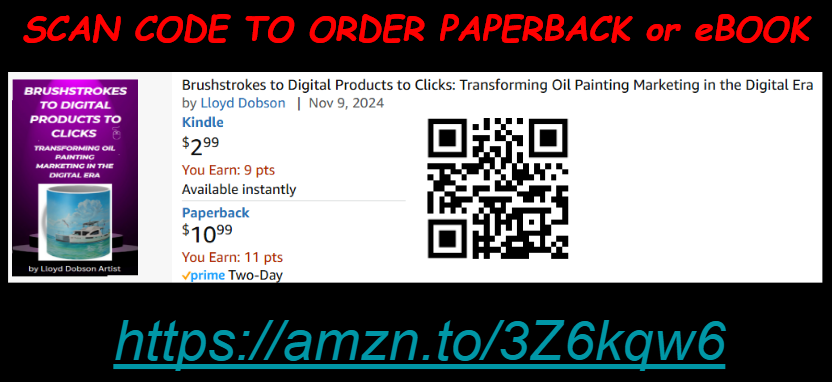Brushstrokes to Digital Products to Clicks: Transforming Oil Painting Marketing in the Digital Era
I recently read “Brushstrokes to Digital Products to Clicks: Transforming Oil Painting Marketing in the Digital Era” and I was thoroughly impressed by its insights into the world of art and marketing.
This book dives into the transformation of traditional oil painting marketing in the digital age. With the rise of technology and social media, artists and art galleries are now able to reach a wider audience and showcase their work in a whole new light. Through this book, the author sheds light on the various strategies and techniques that can be utilized to effectively market oil paintings in this digital landscape.
One of the things I appreciated most about this book was the way it seamlessly blends together the worlds of art and marketing. The author’s passion for both subjects shines through and it made for a compelling and informative read. The book also offers practical tips and advice that can be implemented by artists and galleries looking to make their mark in the digital space.
What I found particularly interesting was the chapter on the use of social media and online platforms for marketing oil paintings. As someone who is familiar with traditional methods of marketing, I was fascinated by the potential of these new avenues and how they can be leveraged to attract a larger audience. The book also delves into the importance of creating a strong online presence and the impact it can have on the success of an artist or gallery.
Overall, I highly recommend “Brushstrokes to Digital Products to Clicks” to anyone interested in the art world, particularly those looking to market oil paintings in the digital era. The author’s writing style is engaging and informative, making it an enjoyable and educational read. I believe this book is a valuable resource for artists, galleries, and anyone looking to expand their knowledge and understanding of the evolving landscape of art marketing.

Lloyd Dobson is a Sarasota-based artist who has been creating stunning oil paintings for over 30 years. His works are renowned for their vibrant colors, intricate details, and unique perspectives that capture the beauty of nature in all its glory. However, what sets Lloyd apart from other artists is his innovative approach to marketing his artwork. In this article, we will explore how Lloyd’s journey as an artist has evolved over time, and how he is using digital products to reach new audiences and sell more of his work.
The Evolution of Oil Painting Marketing
For centuries, artists have relied on traditional methods to showcase and sell their work. This typically involved exhibiting paintings at galleries or art shows, networking with collectors and dealers, and building a reputation through word-of-mouth referrals. While these techniques were effective for many years, they had limitations when it came to reaching larger audiences and generating consistent sales.
Enter Lloyd Dobson, who recognized early on that there was a need for a different approach to selling fine art. He began experimenting with various forms of digital media, including social media platforms like Instagram and Facebook, to share his work with a wider audience. He also started offering limited edition prints and giclée reproductions of his original paintings, which allowed him to reach collectors who may not have been able to afford an original piece.
From Canvas to Computer: How Lloyd Dobson is Reinventing the Art World
Today, Lloyd’s approach to marketing his artwork has become a model for other artists looking to break into the industry. By leveraging technology and digital tools, he has been able to connect with buyers around the world and generate steady income from his art. And while some purists might scoff at the idea of digitizing fine art, Lloyd sees it as a way to make his work accessible to everyone, regardless of their budget or location.
I believe that art should be enjoyed by as many people as possible,” says Lloyd. “By making my work available online and via digital channels, I am able to reach a much broader audience than ever before.”
The Benefits of Digitalizing Fine Art
There are several benefits to digitalizing fine art, both for artists and collectors alike. For one, it allows artists to easily create high-quality reproductions of their work without having to invest in expensive equipment or materials. It also makes it easier for collectors to browse and purchase artwork from the comfort of their own homes, eliminating the need to travel to galleries or art shows. Additionally, digital versions of art can be shared and distributed instantly, allowing artists to build buzz around their latest creations and attract new fans.
 Interview with Lloyd Dobson on His Innovative Approach to Selling Art
Interview with Lloyd Dobson on His Innovative Approach to Selling ArtWe recently sat down with Lloyd to discuss his innovative approach to selling art and get his thoughts on the future of the industry. Here’s what he had to say:
Q: What inspired you to start marketing your artwork online?
A: I realized early on that if I wanted to reach a larger audience and generate consistent sales, I needed to find a way to leverage technology and digital tools. Social media platforms like Instagram and Facebook gave me the perfect opportunity to share my work with a wider audience and engage with potential customers in real-time.
Q: How do you think digitalization has changed the art world?
A: Digitalization has completely revolutionized the art world, making it more accessible and inclusive than ever before. Now, anyone with an internet connection can view and purchase incredible pieces of art from anywhere in the world. This has opened up exciting opportunities for both emerging and established artists, allowing them to reach new markets and expand their fan base.
Q: Do you think digitalization has affected the value of physical artwork?
A: Not necessarily. While digital versions of art can certainly be appreciated and valued in their own right, there is still something special about owning a physical piece of artwork. Collectors often appreciate the tactile experience of seeing and touching a painting in person, and the fact that each piece is unique and cannot be replicated.
Conclusion and Final Thoughts
As the art world continues to evolve, it’s clear that digitalization will play a major role in shaping its future. From social media marketing to virtual reality experiences, there are endless possibilities for how artists can use technology to connect with audiences and sell their work. And while some may lament the loss of traditionally methods, it’s hard to deny the impact that digitalization has already had on the industry. As Lloyd Dobson proves, embracing change and adapting to new trends can lead to success and longevity in any field.
TO ORDER eBOOK or PAPERBACK BOOK – CLICK HERE or IMAGE BELOW


